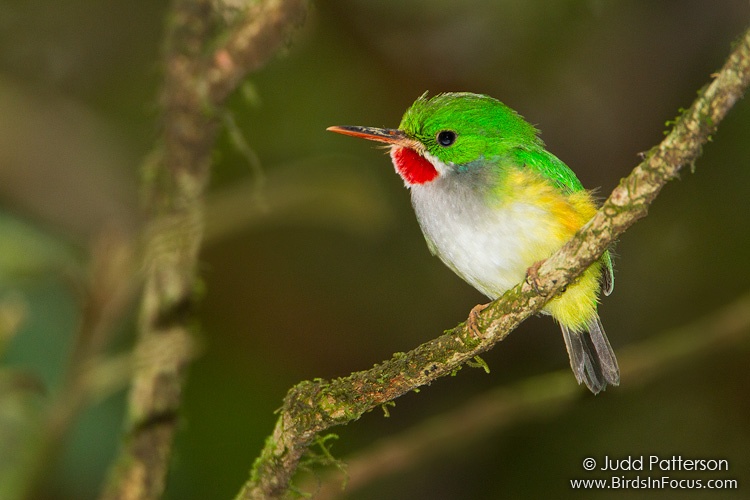
Todus mexicanus
TAXONOMY
Todus mexicanus Lesson, 1838, Tampico and Vera Cruz, Mexico.
Clearly an error: todies do not occur in Mexico.
OTHER COMMON NAMES
French: Todier de Puerto Rico; German: Gelbflankentodi;
Spanish: Barrancolн Puertorriqueсo.
PHYSICAL
CHARACTERISTICS
4.4 in (11 cm), wing
chord 1.7 in (4.3
cm), weight male
0.22 oz (6.3 g), female
0.21 oz (5.9 g).
The least colorful,
smallest tody. Flanks
yellow, no pink, no
blue cheek patch,
belly whitish. Sexual
dimorphism in eye
color: slate (males),
white (females). Juveniles
have four maturation
stages (three weeks) when bill lengthens to adult size,
grayish bib brightens to crimson, and yellow flanks develop.
DISTRIBUTION
Puerto Rico.
HABITAT
Rainforests, arid scrub, coffee plantations, moderately wet
forests, karst (limestone) topography, often near streams.
BEHAVIOR
Maintain year-round home ranges and breeding territories.
Usually single or paired, never in pure flocks although may
temporarily join mixed feeding flocks.
FEEDING ECOLOGY AND DIET
Typical tody. Insectivorous, 50% of diet is flies and beetles.
Also spiders, nematodes, millipedes, lizards, and fruits from six
families (principally Ficus, Chenopodium, Rubus, Xanthoxylum,
Psychotria, Clusia). Adults select sizes and variety of
nestling foods.
REPRODUCTIVE BIOLOGY
Burrow excavation primarily February to May. Tunnel horizontal,
almost always with right-angled curves and enlarged,
depressed, unlined terminal chambers. Average burrow length
in rainforest 13.9 in (30.5 cm). Nest helping common. Clutch
size averages 2-4 eggs.
CONSERVATION STATUS
Not threatened. No recent information on status but populations
diminishing due to habitat destruction and non-shade
coffee.
SIGNIFICANCE TO HUMANS
None known.
Photo Gallery of - Puerto Rican tody




 Animalia Life
Animalia Life